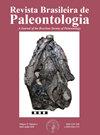通过巴西南部大陆边缘晚第四纪胆石虫的记录推断受精机制
IF 0.6
4区 地球科学
Q4 PALEONTOLOGY
引用次数: 1
摘要
巴西南部大陆边缘晚第四纪球石藻记录的施肥机制。本研究旨在了解巴西大陆边缘南部晚第四纪显著气候事件对海洋初级生产力的影响机制及其关系。在水深1514 m的Pelotas盆地斜坡处,对SIS188海相岩心进行了地球化学和球石藻分析。记录表明,生产力与日晒(以岁差循环为主导)和影响海洋动力学的大气过程有关。在冰川时期(MIS 3和MIS 2),最高的生产力间隔与圣玛尔塔角地区由东北风驱动的上升流系统扩张有关。然而,岩心记录的最大生产力间隔是全新世初期,此时上升流减弱。这种生产力的大幅增加归因于末次盛冰期海平面下降所导致的滞后过程。关键词:生产力;佩洛塔斯盆地;上升流;本文章由计算机程序翻译,如有差异,请以英文原文为准。
Mecanismos de fertilização inferidos através do registro de cocolitoforídeos durante o Quaternário Tardio na Margem Continental Sul-Brasileira
Mechanisms of fertilization inferred from the coccolithophorid record during the Late Quaternary in the southern Brazilian Continental Margin. This study aimed to understand which fertilization mechanisms are preponderant over oceanic primary productivity and its relationship with remarkable climatic events of the Late Quaternary in the south of the Brazilian Continental Margin. The investigation was carried out through geochemical and coccolithophorid analyzes in the SIS188 marine core, recovered from the Pelotas Basin slope at 1,514 m water depth. The record shows that productivity was related to insolation (with a predominance of the precession cycle) and atmospheric processes that influence ocean dynamics. During the glacial period (MIS 3 and 2), the highest productivity intervals were associated with the expansion of the upwelling system in the Santa Marta Cape region, driven by the northeast winds. However, the interval of greatest productivity recorded in the core is the initial Holocene, when the upwelling was attenuated. This substantial increase in productivity is attributed to lagging processes resulting from the decrease in sea level that occurred during the Last Glacial Maximum. Keywords: productivity, Pelotas Basin, upwelling, Quaternary, coccolithophorids.
求助全文
通过发布文献求助,成功后即可免费获取论文全文。
去求助
来源期刊

Revista Brasileira De Paleontologia
PALEONTOLOGY-
CiteScore
1.60
自引率
14.30%
发文量
25
审稿时长
>12 weeks
期刊介绍:
It publishes original contributions on all aspects of Paleontology. Papers are written in English, Spanish, or Portuguese and are reviewed by international experts.
 求助内容:
求助内容: 应助结果提醒方式:
应助结果提醒方式:


